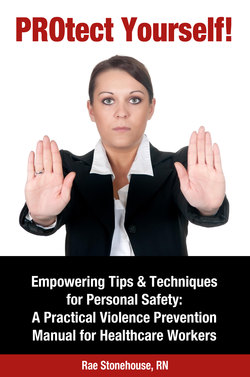Читать книгу PROtect Yourself! Empowering Tips & Techniques for Personal Safety: A Practical Violence Prevention Manual for Healthcare Workers - Rae Stonehouse - Страница 4
На сайте Литреса книга снята с продажи.
Chapter Two OVERVIEW: THE PROBLEM OF VIOLENCE IN THE WORKPLACE
ОглавлениеThere is a disturbing trend in our society towards violence and it is clearly reflected in the growing number of incidents of physical, verbal, and emotional acts of violent, aggressive, assaultive and/or threatening behavior being reported to police.
A report by the Ministry for Women’s Equality [British Columbia, Canada (1999)] noted that one in four women is the victim of domestic violence. Sadly, this trend is reflected in the growing violence against health care providers, most of which are women.
In community care settings, incidents are also on the rise as community care providers care for more high risk clients. Incidents involving aggressive language, slapping, biting, and kicking, while less frequently reported, are also part of the violence toward health care providers.
Statistics would seem to indicate that violence within healthcare is on the rise. I was taught to be wary of statistics. There is an old adage “Figures never lie, but liars can figure.” Now, I’m not saying that statisticians are liars but statistics can be used to illustrate any point. The biggest criticism against current workplace violence statistics is that they do not reflect the true picture.
One reason cited is that violence in the workplace will not always be reported to the employer. The worker may see the event as trivial, or accept some amount or degree of violence as part of the job description. Alternatively, the worker may perceive that there will be no benefit or value in reporting the incident to the employer. Some may feel that they might be blamed for the incident and that their job may be placed at risk if they report it.
Violence at work may also not be reported to the police. Again, the incident may be seen as trivial and as part of the job. Or it may be that the perpetrator of the violence would not likely be charged criminally, given his or her state of mind. This is particularly true of violence from elderly, psychiatric or mentally handicapped clients.
In 1986, while I was working in a psychiatric hospital, a patient purposely attacked and assaulted me. I contacted our local police department and tried to press charges. They just laughed at me and told me that it was part of my job just as it was part of theirs. They said they would press charges if I really wanted to but “why bother the guy was crazy anyway.” I'll leave you to your own thoughts on that one.
Finally, workers are often reluctant to report violence to their Worker’s Compensation Board (WCB). Again, the incident may be viewed as trivial, or as part of the job risk. As mentioned before, how many workers are cautious of reporting because of the idea that they may lose their jobs? It seems to be the new reality that there are people lining up at the door for our job if we can't do it [or some employers would have us believe!] In addition, many workers may see the claims process, i.e. completing the WCB forms, as being too cumbersome. They might bypass this requirement by phoning in sick, utilizing their short term sick leave. You have to wonder how many employers encourage the worker to “book off sick” rather than make a WCB claim. This would keep the employer’s assessment premiums lower. Some workers may erroneously believe that by completing a claims form they are admitting that they were at fault or that blame be placed on them for the incident.
The intent of this manual is to focus on violence in the workplace, specifically in a healthcare setting. Current statistics consistently relate that the nursing profession is composed of 98% women. It is difficult to separate the concept of “work” and “nonwork.” A British Columbia, Canada, initiative “Live Violence Free” from 1998 stated the following facts about Violence Against Women:
Because such a small percentage of violent crime is reported, especially spousal and sexual assaults where women are the primary victims, many of the statistics used in the Live Violence Free information sheets were taken from the Violence Against Women Survey. This 1993 survey by Statistics Canada is the only statistically reliable report on women’s experience of violence.
The survey found that:
•5.38 million Canadian women have experienced violence (of 10.5 m over 18 yrs.)
•One in four Canadian women were victims of assault by a spouse or partner.
•One in three Canadian women were victims of sexual assault.
•Women are the victims in four out of five spousal murders according to 1997 homicide statistics.
•One in two B.C. women were victims of sexual assault.
•One in three B.C. women were victims of assault by a spouse or partner.
•One in six B.C. women were victims of sexual attack by a date or boyfriend.
Young women’s experience of violence
The 1993 Adolescent Health Survey in British Columbia found that:
•32% of girls and 15% of boys between grades 7 - 12 had been sexually and/or physically abused.
Grade 11 girls experienced the highest rate of abuse:
— 28% had been physically abused;
— 28% had been sexually abused.
The previous statistics are Canadian but should serve to illustrate the connection between violence at home i.e. nonwork activities and the workplace.
Let’s look at the concept of violence a little closer.
